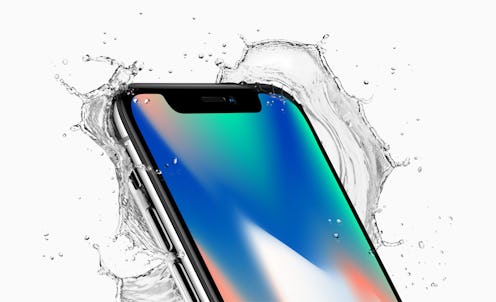News
Here's How Portrait Lighting Will Make Your iPhone Selfies Look So Much More Profesh

With the release on Tuesday of the new iPhone 8, iPhone 8 Plus, and iPhone X, there is a lot for technology aficionados to digest. Among the changes are plenty of specs that are jibberish for those outside the tech realm, but also some exciting software updates that everyone can appreciate, like the changes made to the iPhone's camera technology, including portrait lighting. So what is portrait lighting? This new iPhone 8 feature will make your phone pictures look professional.
Portrait mode was added to the iPhone camera arsenal during the iPhone 7 release, but it could only be utilized with the rear camera, or the non-selfie lens. With the iPhone 8, however, portrait mode can now be used in selfie mode, meaning you're no longer being self-absorbed when you take hundreds of selfies. Now you can say you're capturing your new professional head shot. So it's almost like you're working.
The portrait technology itself has also improved since the last iPhone release. The camera now uses artificial intelligence to examine the contours of your face and create a depth map, so that it can then cast light on you in various flattering ways. The portrait lighting feature on the new fleet of iPhones has five different effects. Natural light, studio light, contour light, stage light and stage light mono are the various lighting options you can choose from, each with its own unique effect.
According to Apple's press release on Tuesday, with the natural light setting, the subject's face is in sharp focus, against a blurred background. When using the studio lighting effect, the subject's face is brightly lit, for what Apple describes as a "clean look." The contour light option casts dramatic shadows with highlights and lowlights.
The most drastic effect is the stage lighting, which turns the background of the photo into a deep black canvas, and spotlights the subject's face in front of it. The stage light mono setting does the same thing, but in black and white. Those who attended the demo attested to the superb quality of the pictures as well.
"You compose a photo, the dual cameras and the ISP sense the scene, they create a depth map, and they actually change the lighting contours over the face," Apple iPhone chief Phil Schiller told Engadget. "These aren't filters, this is real time analysis."
Achieving these different lighting schemes would usually take much more knowledge and equipment than the everyday iPhone photographer has access to. Though it may seem trivial to some who are more focused on the improved processing power or the controversial aesthetics of the new iPhones, this is an impressive display of the advanced technology Apple has created, utilized in an application that most every iPhone user can appreciate.
Portrait lighting isn't the only improvement made to the iPhone 8's camera. The rear camera features a 12-megapixel camera, while the front-facing camera boasts seven megapixels. The phone's improved hardware means that the camera will be able to focus more quickly in low light, always a challenging setting to take quality iPhone photos in. The new hardware will also reduce the graininess that is often unavoidable in low light pictures.
Though some have complained that the iPhone 8 did not improve enough on its predecessor, and are still awaiting requested features like FaceTime for multiple users, better battery life, or even just a charger that lasts more than a few months, portrait lighting is a fun and useful tool that will improve the way even the most amateur photographers take pictures. Whether or not that ability is worth the iPhone 8's high price tag will be up to the consumer to decide.